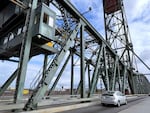
The Hawthorne Bridge is the home of the control room for Multnomah County bridgetenders. "We definitely have a unique perspective." said Bridge Operations Coordinator, Aysha Ghazoul. "We're basically paying attention to the city as a whole. There are fires that happen. Sometimes I'll see a plume of smoke somewhere and it looks really bad, and I'll call the police and say, Hey, do you know that there's some sort of major fire over there? So we're basically on the lookout, not just for vessels, but for any activity. "
Lillian Karabaic / OPB
Have you ever been on your way to work in Portland and been delayed by the dreaded bridge lift? It can be frustrating to be a commuter waiting, but what is it like to be on the other side? Or more precisely, what is it like to be up above?
For the latest installment of OPB’s “At Work With” series, we met with two unsung guardians of Portland’s transportation network: the Multnomah County bridge operators.
An operator is always perched above the Hawthorne Bridge — 24 hours a day, seven days a week. The Hawthorne Bridge control room, suspended above the roadway, is a room with a view: a corner office with windows on every side allowing an eagle-eye perspective of the river and downtown Portland.
Sometimes, it’s not immediately apparent why the bridge is going up. There might not be a boat going through. But water vessels are actually one of the least common reasons the Hawthorne Bridge has to ascend.
As the oldest vertical lift bridge still in operation in the United States, the center span has to be lifted every eight hours to keep the cables greased and the bridge in tip-top operating shape. The whole process takes generally about eight minutes.
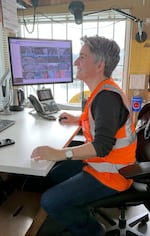
"I'm at a point in my life where I think I've actually found a job," said Multnomah County Bridge Operations Coordinator Aysha Ghazoul, pictured here in February 2024, "This suits me in every way.. I'm not going anywhere. I'm definitely going into retirement with this job."
Mia Estrada / OPB
Bridge Operations Coordinator Aysha Ghazoul and on-call Bridge Operator Dave Hanemann answered your burning bridge operation questions.
What kind of education and experience is needed for the job?
Ghazoul: I mean, the reality is, you cannot do this job if you are afraid of heights.
You need to be someone who [who doesn’t mind] being eight hours on your own. Because remember, full-timers are in a tower on their own 40 hours a week. You need to have attention to detail. Safety is everything with these bridges. When you are opening, you need to know the procedures. It’s not a matter of, well, ‘I’ll remember 90 percent.’ It’s not an option.
Detail-orientated, safety-conscious, showing up on time, making sure you’re passing information off to the operators, reporting things. There are a lot of reports they have to write. Every incident on the bridges, even at the ends of the bridges, gets reported... You have to be on top of all these things, but pretty much there’s no expectation that you have to have some background knowledge... we will train you how to open the bridge.
Hanemann: I don’t think we have a single operator who has the same background. I don’t think any operator has an engineering background per se — I came from broadcast television. The variety of your experience and lived experience is more important. I think the biggest thing is you just have to be able to stay calm because most of the bridge lifts are fine, but every now and then something goes wrong. There’s a set procedure, but you have to remember what the procedure is.
What is the view like?
Ghazoul: We definitely have a unique perspective. We’re basically paying attention to the city as a whole. There are fires that happen. Sometimes, I’ll see a plume of smoke somewhere, and it looks really bad, and I’ll call the police and say, ‘Hey, do you know that there’s some sort of major fire over there?’ So we’re basically on the lookout, not just for vessels, but for any activity.
What do you do all day when there are no boats?
Only the Hawthorne bridge is staffed round-the-clock by one of eight full-time operators, usually working alone. They’re responsible for taking calls from boats and determining if one of the on-call operators needs to open another bridge, based on the height of the river. They also have some routine cleaning tasks, some of which are on the upper machinery level above the control room.
Ghazoul: We need to double-check [the bridges boats ask for.] Sometimes, they’ll say they just need the Hawthorne, and it turns out they actually need the Burnside as well. So we’ll let them know, ‘Actually, based on the height of your boat, there is this much clearance, and you can’t clear the Burnside. So shall we go ahead and get an operator?’
Do you get to leave the tower? Is there a bathroom up there?
Ghazoul: Breaks? There’s no lunch, there’s no breaks. It’s an eight-hour solid straight shift. You’re not leaving.
Every bridge has a bathroom [and] running water, hot water, drinkable water. We need a microwave, a fridge. Because we don’t leave the tower. We’re not allowed to leave the tower. We have to be here for eight hours.
In the summer, if I’m doing a shift on the Burnside, I’ll open the door. I’ll put a little chair out, and I’ll crank the radio. You always want to make sure you’re listening not only for the radio [and] you can hear the phone ring. Generally, no, you’re not wandering off.
There are some cleaning tasks that we have to do. Some of them are on the bridge itself. You have to go outside, you have to sweep, you have to pick up debris, check for tags, whatever it may be. And that’s when you tell the backup operator, “I’m going to head out. I’ve got my radio, I’ve got my cell phone. If you need me, call me. But I’m going to be out. And when I get back, I’ll call you.”
And we’re allowed to kind of walk to the ends of the bridges, and that’s it. And then we have to come back.
With Hawthorne Bridge, because this is such an important bridge, we do not encourage the daytime operator to leave this tower because there’s no one else on those other towers to listen in for you. And while the radios are reliable up top, they’re not necessarily reliable down on the roadway.
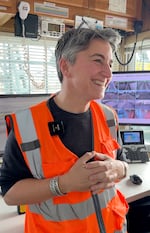
"I'm at a point in my life where I think I've actually found a job," said Multnomah County Bridge Operations Coordinator Aysha Ghazoul, pictured here in February 2024, "This suits me in every way.. I'm not going anywhere. I'm definitely going into retirement with this job."
Mia Estrada / OPB
Has anyone’s boss ever called you to confirm if a bridge lift really happened?
Ghazoul: I’ve never had that!
Hanemann: I have received a call from the public. They somehow had the number and asked, ‘Why’s the bridge opening?’ I’m like, ‘Well, it’s time to open the bridge. It has to open three times a day. And this is one of them. It’ll be open as soon as we can.’
The average lift is eight minutes, so it’s really not that long unless there’s a vessel. But the maintenance lifts are all really pretty short.
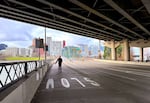
The Hawthorne Bridge, built in 1910, is the oldest vertical lift bridge still in operation in the United States. It has to be lifted every eight hours to keep the cables greased. Multnomah County Bridge Operators watch over it, 24 hours a day, from the control room.
Lillian Karabaic / OPB
Has a bridge ever been stuck while you were on duty?
Ghazoul: I was stuck up in the air with [the Hawthorne] Bridge. It was a soft fault. Soft fault is something that we can actually fix. I have to do it in the middle of the lift while it’s stopped. I’m up in the air. I have to go up to the machinery room: climb a level, go in there, reset it on the panel and then come back down.
Do you give tours?
Ghazoul: Yes! Nathan [Hoover] with PDX Bridge Tours knows the bridges; he knows the history. He often gives school tours. I also go to schools and talk. I take a slideshow, and I just chat to the kids, usually fourth graders. And I love doing that. I mean, talk about one of the best parts of my job.
What’s the hardest part of the job?
Ghazoul: One of the hardest things about being a bridge operator is witnessing really tragic things. I mean, you witness people jumping off the bridge, you witness people really suffering from mental breakdowns, and sometimes [there is] just only so much you can do because you’re in charge of this tower. You can’t just go deal with a situation, and that never gets old or familiar. It’s just really hard to see that.
Hanemann: As an on-caller, the hardest part is not necessarily knowing when you’re working. And so you may have had a family plan or a family gathering or some other thing, and you’re going to have then decide, “Well, do I want to work? Or do I just want to beg off?” You don’t know when you’re working.
Every three months, each on-caller gets a two-week rotation where it’s 24 hours, seven days a week, an hour’s notice. The rest of the time, you’re third or fourth on the list.
When you are working, the hardest thing is three o’clock in the morning. It is really just a nasty, nasty time of night when you still have four more hours. You’re only halfway through. And especially if you got called late. If you didn’t know you were working until eight o’clock the night before, it’s rough.
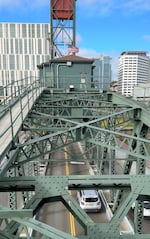
The view from the machinery level of the Hawthorne Bridge. "During the summer when you come out here to check the cabling and stuff, it's really nice," said On-Call Bridge Operator Dave Hanemann. "People are on the river. It's warm. You can hear music and everything. Sometimes if you're here for the Blues Festival, you get a free concert. "
Mia Estrada / OPB
Does anyone ever try to run the light?
Ghazoul: Almost every time ... they want to basically get through before it goes up, because they don’t realize that it’s actually not that long of an opening. It’s only about eight minutes, but they don’t know that.
[During a bridge lift], I’m constantly walking back and forth [between the windows] because these barriers are huge. I’m making sure that nobody is ducking under the gates or getting impatient because we don’t want these things to hit anybody.
What’s the busiest time of year?
Ghazoul: People complain during Rose Festival, when the vessels are coming through. Sometimes all the bridges are open for 40 minutes because [of] the military ships, we don’t have an option. We have to open it. We can’t be closing and opening them. People will call and say, “I’m late for an appointment.”
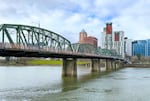
The Hawthorne Bridge, built in 1910, is the oldest vertical lift bridge still in operation in the United States. It has to be lifted every eight hours to keep the cables greased. Multnomah County Bridge Operators watch over it, 24 hours a day, from the control room.
Lillian Karabaic / OPB
Do you have donuts up there?
Ghazoul: We do not have donuts. But if someone wants to bring us donuts, do not show up here and bring us donuts. We’ll figure out another time.
Do you have a favorite bridge?
Ghazoul: The Burnside. I love architecture, and to me, that’s the most beautiful bridge. I love 1920s architecture. They just don’t build bridges like that anymore. And I love the towers. They’re these octagonal, hexagonal little castles; they’re beautiful. And there’s a walkway where we can open the tower door, and walk out and talk to the public, which I love. I love that sort of interaction that you get.
The Burnside is the easiest bridge to open, the fewest number of procedures. So, very quickly you can open the bridge.
Hanemann: The Morrison because it’s second closest to my home, so it’s easy to get to. It has the best bike parking because I park my bike in the other tower, and it’s just open and easy to get into. I like the view better than the Burnside, or the Broadway Bridge. It’s just unobstructed. The architecture isn’t great, but the view and the size of the tower and the convenience to home is why I chose it.
Hardest bridge to work on?
Ghazoul: Broadway is the most complicated because there are an additional five steps. We have the cantoniera that belong to streetcar; we need to lower those, and raise them ourselves and disconnect the electric, because otherwise, they’ll get crushed.
What’s your favorite view from the bridges?
Ghazoul: When the sun is rising... all the crows fill up the trees on the riverfront, and they all fly — I don’t know where — but I know Southeast. They’re really beautiful.
Has operating the bridges changed your relationship with the Willamette?
Ghazoul: Yes. I’ve lived here for 30 years. I came to America when I was 21, and I lived downtown, and I was here when the flood happened, the 1996 flood. So, I would walk to the river and witness it rise and fall.
But then I moved to the east side, and I feel like for many, many years I was a little disconnected from both the downtown and the river.
Now, I’m on this bridge. Every week I’m on this river, I kayak in it. I swim in it. I love it. I feel like I’m way more connected to this river than I ever was. I even put my cat’s ashes in this river. I know we’re probably not supposed to do that.
I grew up in three different continents, and every place I grew up had a river. And so for me, rivers have become extremely important to me, but I do feel the fact that I’m on it every day, There’s no question. I feel a connection to it.
You can’t help but feel connected to the bridges, connected to the city, to the river, to the people. We are county employees. We work for the people, and it’s amazing the joy that we get from being here.
